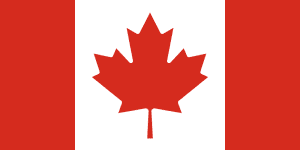
| Colors | HEX Code | RGB | CMYK |
|---|---|---|---|
| Red | #D52B1E | 213, 43, 30 | 0, 80, 86, 16 |
| White | #FFFFFF | 255, 255, 255 | 0, 0, 0, 0 |
The Canadian flag is made of three horizontal stripes. The left and right parts are red, while the middle part is white. On the white part, there is a large red maple leaf in the center of the flag.
Meaning of the Canadian Flag
The red and white colors represent the natural settings in Canada. The white represents the snow that covers the country, and the red color stands for the maple leaves color in autumn. The maple leaf in the middle represents the national symbol of the country.
History of the Canadian flag
Canada did not have a flag of its own. The French and British flags were used. Before and after the Confederation in 1867, the United Kingdom’s Royal Union Flag, commonly known as the Union Jack, was used in Canada. Then in the 1870s, Canada had a red flag with the Union Jack and a shield. There were different versions of the flag, changing the shield as more states joined the confederation.
Canada had a lot of struggles around the flag and could not reach a consensus. The political leaders promised to solve the issue of the flag in 1963. There were a lot of suggested designs, but the winner was that of George Stanley, Dean of Arts at the Royal Military College (RMC) in Kingston, Ontario who suggested the idea of a flag featuring a single red maple leaf on a white background and two red borders. The maple leaf was a popular symbol since the 19th century that was used on all popular cultural items. Then it became a national emblem during WWI. So the new maple leaf flag was made official by a proclamation from Queen Elizabeth II on January 28, 1965.